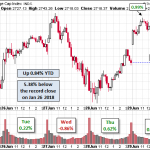According to figures released by the US Bureau of Economic Analysis, real gross domestic product increased at an annualized rate of 0.7% in the first quarter of 2017. This was the first “advance” estimate and is largely in line with the Atlanta Fed’s GDP now tracker, which had declined significantly in recent weeks to a mere 0.2%. In the fourth quarter of 2016, real GDP increased 2.1%.
Why this matters. Despite the downtick in GDP, the Fed is expected to continue its rate hiking campaign. The Fed has signalled it sees these data as one-offs and maintain a tightening bias that they believe still provides easing. Put another way, while the Fed believes its policy stance is still accommodative, it will tighten its stance at a moderate pace that will depend on incoming data.
The next two FOMC policy meeting occur before the next GDP data come out. So the Fed will have to decide on a rate hike twice before we get Q2 numbers. Right now, this setup looks bearish for short-term Treasurys. With demand for long-dated safe assets high, the yield curve will remain under flattening pressure. And that, combined with higher short-term rates will be negative for bank net interest margins and earnings.














Leave A Comment